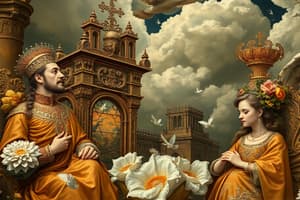Podcast
Questions and Answers
How did Baroque art differ from that of Reformation art?
How did Baroque art differ from that of Reformation art?
It was ornamental and complex.
Who commissioned Protestant artists?
Who commissioned Protestant artists?
the wealthy
What is iconoclasm?
What is iconoclasm?
the destruction of religious images and icons
How did the invention of the printing press affect the art market?
How did the invention of the printing press affect the art market?
Which Baroque artist from a Protestant country did NOT produce work for the Catholic Church?
Which Baroque artist from a Protestant country did NOT produce work for the Catholic Church?
Which is NOT a characteristic of Baroque architecture?
Which is NOT a characteristic of Baroque architecture?
What was typical of Baroque art?
What was typical of Baroque art?
What was Caravaggio's chiaroscuro technique?
What was Caravaggio's chiaroscuro technique?
Which statement describes the revolution that the invention of the printing press brought to visual culture?
Which statement describes the revolution that the invention of the printing press brought to visual culture?
What is Johannes Gutenberg famous for?
What is Johannes Gutenberg famous for?
Which printmaking technique was commonly used to translate oil paintings to printed form?
Which printmaking technique was commonly used to translate oil paintings to printed form?
Printing increased the value of original works of art.
Printing increased the value of original works of art.
What are relief prints generally made from?
What are relief prints generally made from?
Who discovered that light splits into seven colors when passing through a prism?
Who discovered that light splits into seven colors when passing through a prism?
Which painting by Georges Seurat is an excellent example of color theory?
Which painting by Georges Seurat is an excellent example of color theory?
What can we conclude about Leonardo da Vinci from his anatomical drawings?
What can we conclude about Leonardo da Vinci from his anatomical drawings?
What best describes the principle of the camera obscura?
What best describes the principle of the camera obscura?
What does David's painting Napoleon in His Study at the Tuileries represent?
What does David's painting Napoleon in His Study at the Tuileries represent?
Which of David's paintings conveyed a call to revolutionary action?
Which of David's paintings conveyed a call to revolutionary action?
Which of David's paintings represents the murder of one of the Jacobin leaders?
Which of David's paintings represents the murder of one of the Jacobin leaders?
What does Versailles symbolize?
What does Versailles symbolize?
Which artists apply colors in small brush strokes, making their paintings lively depictions when seen from a distance?
Which artists apply colors in small brush strokes, making their paintings lively depictions when seen from a distance?
Which artist was part of the expressionist movement?
Which artist was part of the expressionist movement?
Which art movement does Edvard Munch's painting The Scream represent?
Which art movement does Edvard Munch's painting The Scream represent?
In Piet Mondrian's Broadway Boogie-Woogie, what inspired the artist to paint yellow lines?
In Piet Mondrian's Broadway Boogie-Woogie, what inspired the artist to paint yellow lines?
Flashcards are hidden until you start studying
Study Notes
Baroque Art and Reformation Art
- Baroque art originated in the late sixteenth century, characterized by its ornamental and complex style.
- Catholic artists produced religious themes, while Protestant artists often focused on secular subjects.
- Wealthy patrons commissioned works from Protestant artists.
Iconoclasm and Religious Art
- Iconoclasm refers to the destruction of religious images and icons, prevalent due to Protestant critiques of religious art.
Impact of the Printing Press
- The invention of the printing press enabled the production of affordable art prints, transforming the art market.
- It enhanced accessibility for middle and lower classes, revolutionizing visual culture.
- Johannes Gutenberg is credited with inventing the printing press.
- The mezzotint printmaking technique was widely used to translate oil paintings into prints.
Baroque Characteristics and Techniques
- Baroque architecture typically features large, elaborate structures, contrasting with small and simple buildings.
- A common characteristic of Baroque art includes dark backgrounds with subjects illuminated by light.
- Caravaggio's chiaroscuro technique highlights dramatic contrasts between light and shadow.
Notable Artists and Their Works
- Rembrandt van Rijn is a renowned Baroque artist from a Protestant background who did not create works for the Catholic Church.
- Georges Seurat's painting "A Sunday on La Grande Jatte" exemplifies color theory through the blending of adjacent hues.
- David's painting "Napoleon in His Study at the Tuileries" portrays Napoleon as a formidable leader, while his work "Oath of Horatii" calls for revolutionary action, and "Death of Marat" depicts the murder of a Jacobin leader.
- Versailles symbolizes the idea of absolutism.
19th Century Movements
- Impressionists applied colors using small brush strokes, resulting in vibrant paintings when viewed from a distance.
- Vincent van Gogh was a significant figure in the expressionist movement, known for altering forms and using color expressively.
- Edvard Munch's painting "The Scream" embodies expressionism, conveying feelings of anxiety and isolation through color and form.
Scientific Influence on Art
- Isaac Newton discovered that light passing through a prism splits into seven colors, laying groundwork for understanding color theory.
- Piet Mondrian's abstract work "Broadway Boogie-Woogie" drew inspiration from the yellow lines of New York City cabs.
Studying That Suits You
Use AI to generate personalized quizzes and flashcards to suit your learning preferences.




